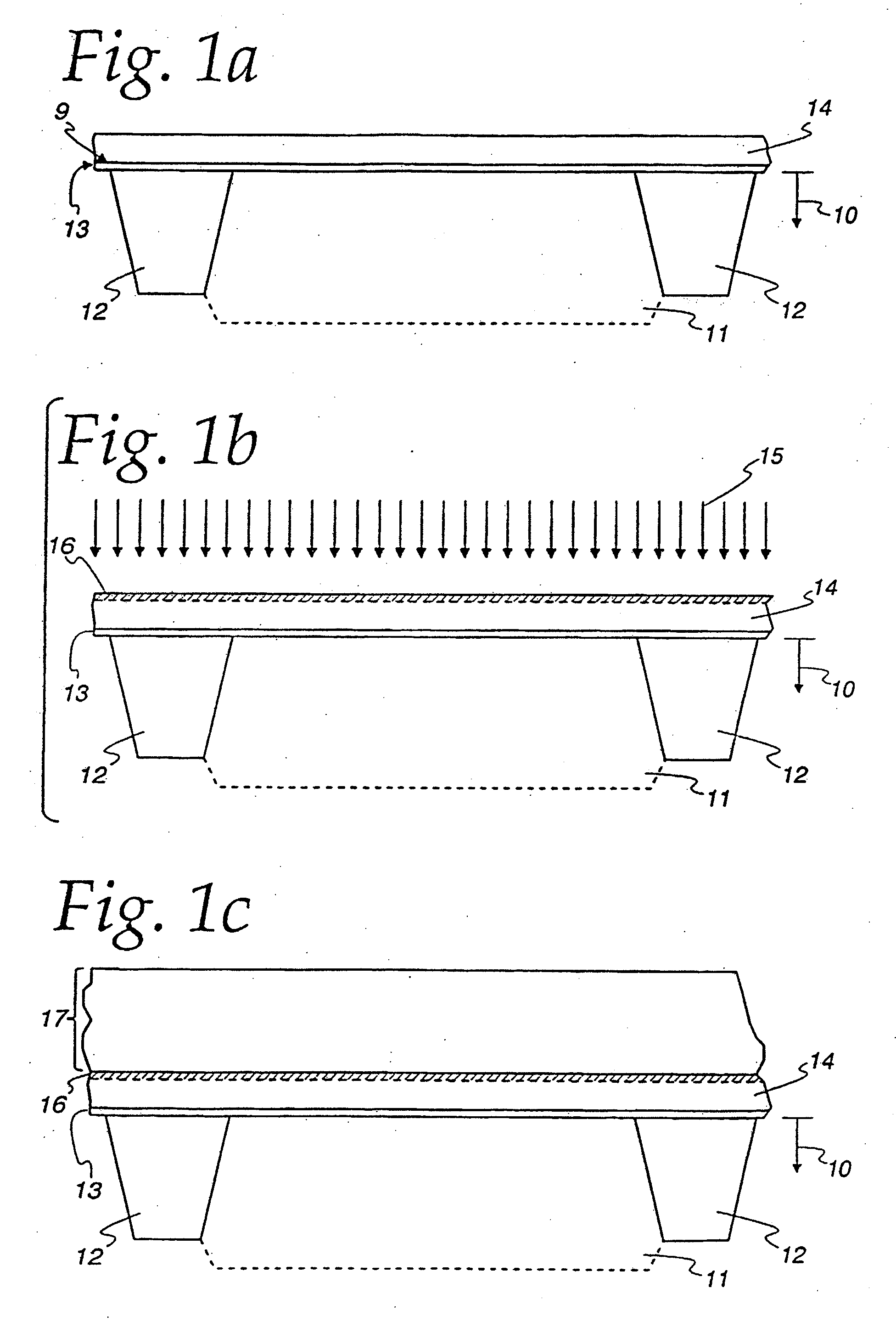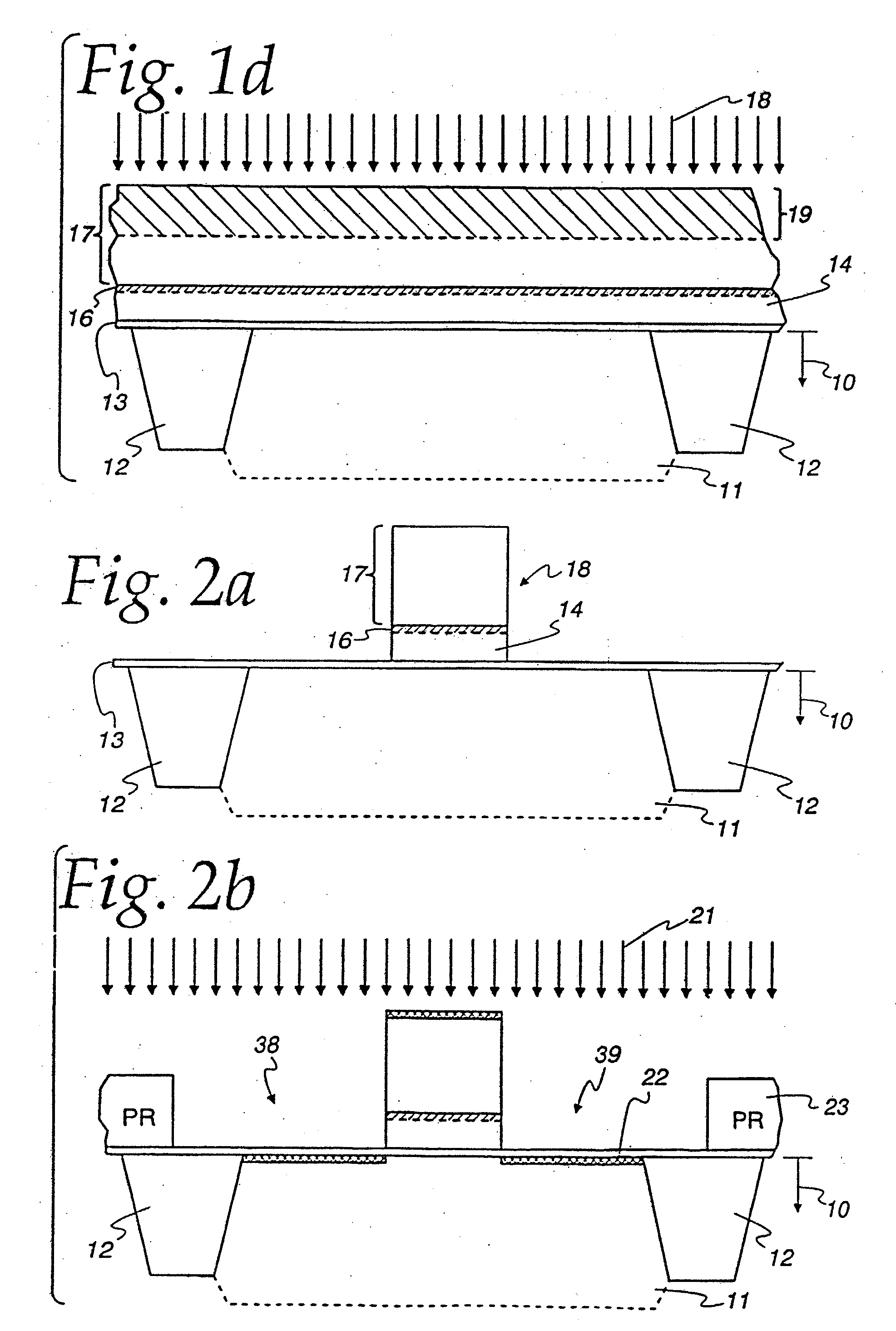There are various technical issues related to conventional
CMOS processes as technology scaling progresses with regard to the doping of the gate electrode.
First, as the gate
dielectric thickness is scaled down, the
field intensity at the gate electrode / gate dielectric interface increases with the result that the gate electrode experiences depletion of charge starting at the dielectric interface.
Further, there is a competing issue that attempts to increase the doping of the gate electrode at the electrode / dielectric interface which enhances the risk of dopant
diffusion through the gate dielectric and into the channel, particularly for
boron doped gates.
The
grain boundary dopant at the gate electrode / gate dielectric interface is then a risk for gate dielectric penetration as the heat treatment continues.
This risk is increased as the heat treatment goes to higher temperatures and longer times. There are practical limits to the reduction of time / temperature for the gate electrode anneal, due to the need to diffuse the dopant to the gate electrode / gate dielectric interface and the need to electrically activate the implanted dopant, for example, as disclosed in M. Kase, et al.
The oxynitride gate dielectric is useful for the reduction of the
boron penetration through the
gate oxide, but does not help with the gate depletion effect.
The problem is that the SiGe gate material degrades the NMOS characteristics and thus requires complex selective technologies to achieve a full
CMOS solution.
The
metal gate approach solves the
boron penetration problem (no boron to diffuse) and the gate depletion issue (near infinite charge concentration) but makes setting the
threshold voltage for, NMOS and PMOS simultaneously very difficult.
The
metal gate approach also has significant challenges in
process integration; since the
metal layers are not physically stable at the high temperatures of the heat treatments required for implant activation, such as required by the source and drain regions.
The conventional device faces other limiting factors as technology scales.
With continued scaling, for example <0.1 um technology, the conventional device suffers from the need to provide sufficient gate overlap of the drain extension region to ensure high performance operation.
However, the process used by Ghani, et al in the demonstration devices is very constraining relative to large-scale production requirements: the structure requires a tilt implant selectively on the source side and not the drain side.
To manufacture devices with such a structure would require limiting the
layout so that all sources are to one side and all drains to the other, making the circuit very large.
There are difficulties with continuing the historical methods of scaling the
junction depth.
These implants have low productivity on a conventional implanter because they are in the regime where Child's Law applies; implants with energy of less than 10 keV.
While this method is able to increase productivity by around 2×, the deceleration beam has issues with energetic
contamination and nonuniformity of implant results.
There are further issues with the conventional implant process for the formation of ultrashallow junctions in that the implant creates defect structures within the
silicon implanted layer that
pose more of an issue as the energy is reduced and the layer becomes shallower.
First, the density of created defects increases quickly because the implanted volume of the substrate material is reduced as the implant is made shallow.
Since the doses are either the same or increasing, the reduction of implant depth corresponds to an increase in both the density of implanted dopant and the implant defects.
As the defect density increases, the probability of interaction increases dramatically, with the problem that combinations of defects make more complex defect structures which are very difficult to anneal.
This is particularly an issue when the dopant concentration exceeds the
solid solubility, since the supersaturated dopant tends to precipitate into undesirable structures.
For example, supersaturated boron tends to precipitate into
silicon boride (SiB4), a structure which binds the boron into electrically inactive position, rendering that component of the boron implant completely ineffective.
The conventional process also places extreme constraints on the heat treatment, or anneal, used to make the implanted dopant electrically active.
There is a strong conflict between the need to heat the substrate to high temperatures to effectively activate the implanted dopant versus the need to limit the temperature and time of the anneal to prevent
diffusion.
The method has the
disadvantage, though, that diffusion through
oxide is generally slower than through
silicon, for example, as discussed in Fair, “Physical Models of
Boron Diffusion in Ultrathin Gate Oxides”J. Electrochem. Soc, 144, 1997, p.
A further issue with the conventional process is the difficulty in avoiding implanting into an
oxide while attempting to form an ultrashallow junction, for example, as discussed in Krull, et al, “The importance of the native
oxide for sub-keV ion implants,”Proc.
As technology scales and the implant energy is reduced, it becomes increasingly difficult to remove the
surface oxide well enough that it does not interfere with the ion implant process.
 Login to View More
Login to View More  Login to View More
Login to View More 


